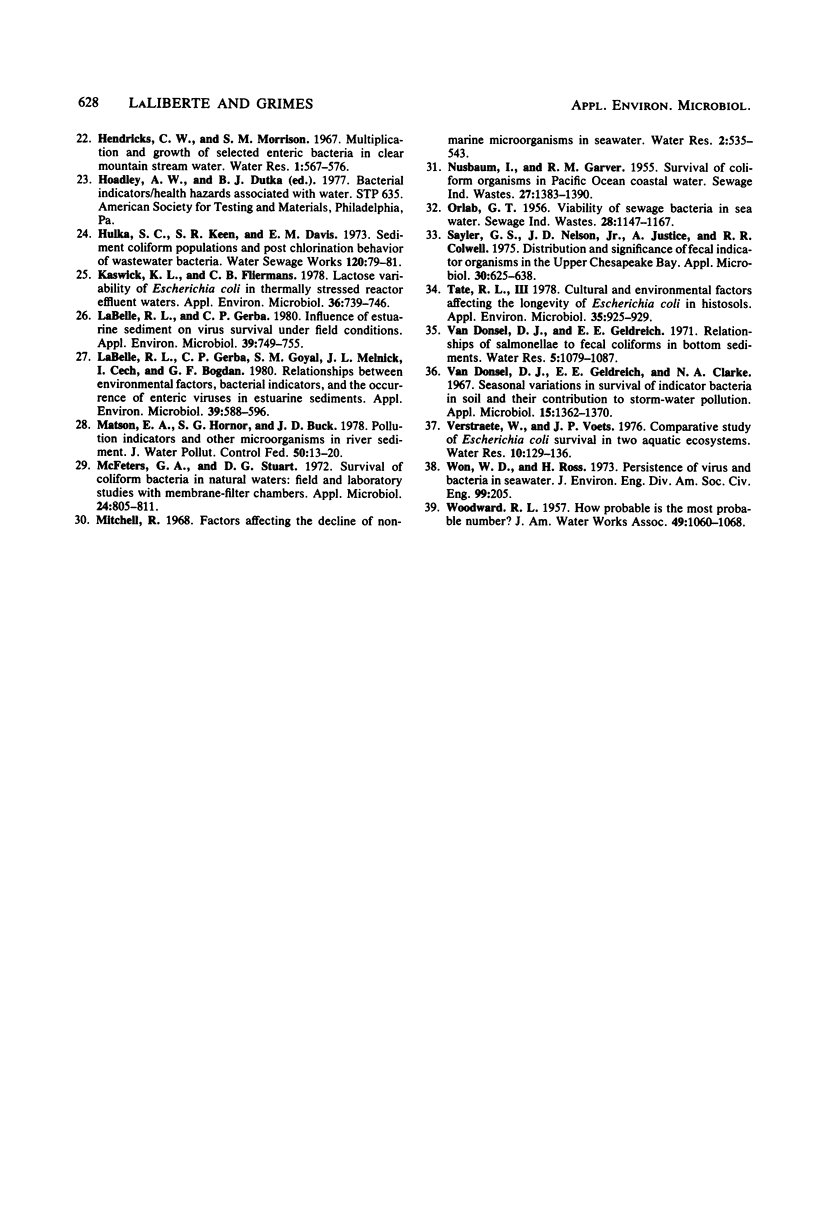Abstract
The survival of Escherichia coli in bottom sediment (Lake Onalaska, navigation pool no. 7, Mississippi River) was studied by using in situ dialysis culture of sterile (autoclaved) and unsterile sediment samples. Bags made from dialysis tubing were filled with either course sand sediment (28.8% fine) or organic, silty clay sediment (77.2% fine) and placed at the sediment-water interface. Bags representing sterile controls, unsterile uninoculated controls, autoclaved inoculated sediment, and unsterile inoculated sediment were studied during a 5-day period for each sediment type. Daily most-probable-number determinations indicated that E. coli populations in unsterile inoculated sediment fluctuated between 5.3 X 10(2) and 2.2 X 10(3) bacteria per g of silty clay and between 3.0 X 10(3) and 1.4 X 10(4) bacteria per g of sand. Autoclaved silty clay sediment inoculated with 1.0 X 10(6) bacteria per g increased to 2.2 X 10(8) bacteria per g in 3 days. During the same period, autoclaved sand sediment inoculated with 1.2 X 10(5) cells per g increased to 5.4 X 10(7) bacteria per g. By day 5, populations in both cultures had decreased by 1 log. The ability of E. coli to survive for several days in aquatic sediment in situ suggests that fecal coliforms in water may not always indicate recent fecal contamination of that water but rather resuspension of viable sediment-bound bacteria.
Full text
PDF





Selected References
These references are in PubMed. This may not be the complete list of references from this article.
- ALLEN L. A., GRINDLEY J., BROOKS E. Some chemical and bacterial characteristics of bottom deposits from lakes and estuaries. J Hyg (Lond) 1953 Jun;51(2):185–194. doi: 10.1017/s0022172400015618. [DOI] [PMC free article] [PubMed] [Google Scholar]
- ALLEN L. A., PASLEY S. M., PIERCE M. A. F. Some factors affecting the viability of faecal bacteria. J Gen Microbiol. 1952 Aug;7(1-2):36–43. doi: 10.1099/00221287-7-1-2-36. [DOI] [PubMed] [Google Scholar]
- Baross J. A., Hanus F. J., Morita R. Y. Survival of human enteric and other sewage microorganisms under simulated deep-sea conditions. Appl Microbiol. 1975 Aug;30(2):309–318. doi: 10.1128/am.30.2.309-318.1975. [DOI] [PMC free article] [PubMed] [Google Scholar]
- CARLUCCI A. F., PRAMER D. An evaluation of factors affecting the survival of Escherichia coli in sea water. IV. Bacteriophages. Appl Microbiol. 1960 Jul;8:254–256. doi: 10.1128/am.8.4.254-256.1960. [DOI] [PMC free article] [PubMed] [Google Scholar]
- Coleman R. N., Campbell J. N., Cook F. D., Westlake D. W. Urbanization and the microbial content of the north Saskatchewan River. Appl Microbiol. 1974 Jan;27(1):93–101. doi: 10.1128/am.27.1.93-101.1974. [DOI] [PMC free article] [PubMed] [Google Scholar]
- Geldreich E. E., Clarke N. A. Bacterial pollution indicators in the intestinal tract of freshwater fish. Appl Microbiol. 1966 May;14(3):429–437. doi: 10.1128/am.14.3.429-437.1966. [DOI] [PMC free article] [PubMed] [Google Scholar]
- Gerba C. P., Goyal S. M., LaBelle R. L., Cech I., Bodgan G. F. Failure of indicator bacteria to reflect the occurrence of enteroviruses in marine waters. Am J Public Health. 1979 Nov;69(11):1116–1119. doi: 10.2105/ajph.69.11.1116. [DOI] [PMC free article] [PubMed] [Google Scholar]
- Gerba C. P., McLeod J. S. Effect of sediments on the survival of Escherichia coli in marine waters. Appl Environ Microbiol. 1976 Jul;32(1):114–120. doi: 10.1128/aem.32.1.114-120.1976. [DOI] [PMC free article] [PubMed] [Google Scholar]
- Goyal S. M., Gerba C. P., Melnick J. L. Occurrence and distribution of bacterial indicators and pathogens in canal communities along the Texas coast. Appl Environ Microbiol. 1977 Aug;34(2):139–149. doi: 10.1128/aem.34.2.139-149.1977. [DOI] [PMC free article] [PubMed] [Google Scholar]
- Grimes D. J. Bacteriological water quality effects of hydraulically dredging contaminated upper Mississippi River bottom sediment. Appl Environ Microbiol. 1980 Apr;39(4):782–789. doi: 10.1128/aem.39.4.782-789.1980. [DOI] [PMC free article] [PubMed] [Google Scholar]
- Grimes D. J. Release of sediment-bound fecal coliforms by dredging. Appl Microbiol. 1975 Jan;29(1):109–111. doi: 10.1128/am.29.1.109-111.1975. [DOI] [PMC free article] [PubMed] [Google Scholar]
- Hendricks C. W. Enteric bacterial metabolism of stream sediment eluates. Can J Microbiol. 1971 Apr;17(4):551–556. doi: 10.1139/m71-090. [DOI] [PubMed] [Google Scholar]
- Kasweck K. L., Fliermans C. B. Lactose variability of Escherichia coli in thermally stressed reactor effluent waters. Appl Environ Microbiol. 1978 Nov;36(5):739–746. doi: 10.1128/aem.36.5.739-746.1978. [DOI] [PMC free article] [PubMed] [Google Scholar]
- LaBelle R. L., Gerba C. P., Goyal S. M., Melnick J. L., Cech I., Bogdan G. F. Relationships between environmental factors, bacterial indicators, and the occurrence of enteric viruses in estuarine sediments. Appl Environ Microbiol. 1980 Mar;39(3):588–596. doi: 10.1128/aem.39.3.588-596.1980. [DOI] [PMC free article] [PubMed] [Google Scholar]
- LaBelle R. L., Gerba C. P. Influence of estuarine sediment on virus survival under field conditions. Appl Environ Microbiol. 1980 Apr;39(4):749–755. doi: 10.1128/aem.39.4.749-755.1980. [DOI] [PMC free article] [PubMed] [Google Scholar]
- Matson E. A., Hornor S. G., Buck J. D. Pollution indicators and other microorganisms in river sediment. J Water Pollut Control Fed. 1978 Jan;50(1):13–19. [PubMed] [Google Scholar]
- McFeters G. A., Stuart D. G. Survival of coliform bacteria in natural waters: field and laboratory studies with membrane-filter chambers. Appl Microbiol. 1972 Nov;24(5):805–811. doi: 10.1128/am.24.5.805-811.1972. [DOI] [PMC free article] [PubMed] [Google Scholar]
- Sayler G. S., Nelson J. D., Jr, Justice A., Colwell R. R. Distribution and significance of fecal indicator organisms in the Upper Chesapeake Bay. Appl Microbiol. 1975 Oct;30(4):625–638. doi: 10.1128/am.30.4.625-638.1975. [DOI] [PMC free article] [PubMed] [Google Scholar]
- Tate R. L., 3rd Cultural and environmental factors affecting the longevity of Escherichia coli in Histosols. Appl Environ Microbiol. 1978 May;35(5):925–929. doi: 10.1128/aem.35.5.925-929.1978. [DOI] [PMC free article] [PubMed] [Google Scholar]
- Van Donsel D. J., Geldreich E. E., Clarke N. A. Seasonal Variations in Survival of Indicator Bacteria in Soil and Their Contribution to Storm-water Pollution. Appl Microbiol. 1967 Nov;15(6):1362–1370. doi: 10.1128/am.15.6.1362-1370.1967. [DOI] [PMC free article] [PubMed] [Google Scholar]


